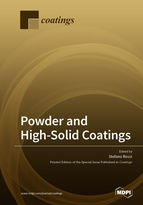Powder and High-Solid Coatings
A special issue of Coatings (ISSN 2079-6412). This special issue belongs to the section "Surface Characterization, Deposition and Modification".
Deadline for manuscript submissions: closed (31 January 2022) | Viewed by 27866
Special Issue Editor
Interests: coatings for corrosion protection and perception properties
Special Issues, Collections and Topics in MDPI journals
Special Issue Information
Dear Colleagues,
Organic coatings are the most used and effective method to guarantee corrosion protection properties for metal alloys. In particular, for steel and alluminum alloys, paints could guarantee excellent protection and the physical appearance due to surface finishing and colors. Traditionally, for the application of paints, organic solvents are used in the production of Volatile Organic compounds (VOCs) and have a high impact on the environment and problems regarding safety during application. In the last few decades, several environmental protection regulations have searched for a way to reduce the emission of VOCs, which motivated researchers, professionals, and industry to develop solvent-free coatings technologies. In particular, powder organic coatings, in Europe, and high solid coatings in America, seem to guarantee the best performances with the lowest environmental impacts. These coatings tend to substitute traditional solvent paints in more and more applications. Considering the environmental impacts, these coatings are more suitable for protection of outdoor structures and indoor products, in particular in domestic applications. The development of deposition technologies and the increased quality of organic matters, different surface textures and a quasi-infinite color palette allow the use of this kind of paint in applications, not only for corrosion protection aspects, but also the aesthetic aspects.
In this regard, this Special Issue intends to publish original research and review papers, from investigators, academia and industry, considering all aspects and applications of powder and high solid organic coatings. Studies in the field of applications process, corrosion protection, aesthetical properties, weathering changes of properties, service life studies, comparison between accelerated laboratory test and natural weathering, examples of substitution of traditional solvent paints are encouraged. New polymeric matter, new textures and bioinspired surface effects are also welcome.
Prof. Dr. Stefano Rossi
Guest Editor
Manuscript Submission Information
Manuscripts should be submitted online at www.mdpi.com by registering and logging in to this website. Once you are registered, click here to go to the submission form. Manuscripts can be submitted until the deadline. All submissions that pass pre-check are peer-reviewed. Accepted papers will be published continuously in the journal (as soon as accepted) and will be listed together on the special issue website. Research articles, review articles as well as short communications are invited. For planned papers, a title and short abstract (about 100 words) can be sent to the Editorial Office for announcement on this website.
Submitted manuscripts should not have been published previously, nor be under consideration for publication elsewhere (except conference proceedings papers). All manuscripts are thoroughly refereed through a single-blind peer-review process. A guide for authors and other relevant information for submission of manuscripts is available on the Instructions for Authors page. Coatings is an international peer-reviewed open access monthly journal published by MDPI.
Please visit the Instructions for Authors page before submitting a manuscript. The Article Processing Charge (APC) for publication in this open access journal is 2600 CHF (Swiss Francs). Submitted papers should be well formatted and use good English. Authors may use MDPI's English editing service prior to publication or during author revisions.
Keywords
- organic coatings;
- environmental friendly paints;
- colored paint;
- high performances paints;
- organic powder coatings;
- solvent less paints;
- low VOC paints;
- aesthetical organic coatings;
- corrosion protection properties;
- accelerated test;
- simulating aggressive environments.






